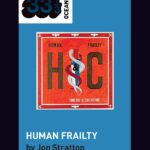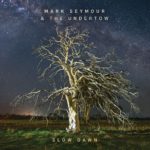What’s A Few Miles?
What’s A Few Men? era Mark Seymour interview.
Author: Andrew Watt, RAM.
Date: 2 December 1987.
Original URL: N/A.
Where They Came From
There was a time not so long ago (although to all concerned it seemed a lot longer) when Mark Seymour expressed his amusement that navy blue singlets had become de rigueur attire at Melbourne’s hippest establishment, the Hardware Club.
Unwittingly, Seymour’s preference in stage garb had become a sub-culture fashion command – reflective of the role his band Hunters & Collectors played in the scene of that time. Those were the days when there were really only two ideologically sound gigs to be at in Melbourne – the Models or the Hunters.
It’s late 1987 now and the Hardware Club is gone – so too are the Models, for all intents and purposes. But Mark Seymour still wears blue singlets on stage (or at least close approximations of them). Hunters & Collectors are now public property, and yes, the music has changed accordingly. No longer a confusing (and confused) industrial funk band weighed down with the superficial accoutrements of art-rock pretension, the Hunters have nearly completed an evolution that Seymour hinted at in early 1986 when we discussed, of all things, the symbolic relevance of blue singlets.
“It’s not an image that we adopted overnight. It’s something we just fell into because we tried to avoid being the definitive ‘art-rock’ image band that we were when we started. We were wearing tails and dinner suits way before anyone else. We’d done all that and realized what bullshit it is, and that it was such a complete sham. When we divested ourselves of it, there was nothing else we could put on except what was underneath.
“The thing I find curious about the inner city fringe is that they adopt fashion and bands like a change in the weather. I was always under the impression that my peers were the ones setting the pace – the ones who really were defining style were out in the suburbs. You always find that the people who have an intellectual approach to art and music are the ones who latch onto things for all the wrong reasons.”
How They Got Here
…But all that was before Human Frailty. The relevance of that album to the evolution of Hunters & Collectors has already been extensively documented, and it doesn’t really bear regurgitating. The real significance of that album is that it achieved a widespread acknowledgment of Seymour’s songwriting. For the first time he could believe in the validity of his songs without having to clothe them in musical and lyrical disguises. In their clarity lay their power, and the broad acceptance of his particular vision was a liberating agent for Seymour. It was best understood by his response to a question about where Hunters & Collectors would be had Human Frailty been received differently on a commercial level.
“I’d be pretty surprised if we were still playing together in pubs. You do expect a certain amount of social recognition for what you do. If Human Frailty was received the same ways as Jaws Of Life, we would probably have broken up or at least gone off to alternative things. We might have treated Hunters & Collectors as a project rather than a career.”
Where They Are Now (Part 1)
You don’t need to be a musical Rhodes Scholar to realize the importance of What’s a Few Men? to the evolution of Hunters & Collectors.
If Human Frailty was their watershed album, the What’s a Few Men? had to both consolidate its effect and take it a step further. Realising the significance of this, the band opted for a trial run with producer Greg Edward (Mellencamp, R.E.M., Brian Setzer). The result was the EP, Living Daylights, released earlier this year.
Prior to the recording of the EP, Seymour had explained the need for a producer to understand the ethics that govern Hunters & Collectors’ creative process…
“It’s important for a band like us, because we work as a community in the studio. The advance planning is all pretty much according to a set pattern of behavior that everyone gets involved in. He’ll have to be on that level with us or otherwise it just won’t work. We’re not the sort of band you can mould.”
Speaking after the completion of the new album, Seymour is able to report that the relationship with Edward was a success. It’s quite an achievement in light of Seymour’s opinion that the Hunters are an “incredibly hard” band to produce…
“We’re really difficult because we work as a team of people who have produced our sound live really well. Our whole thing is based on this really physical act of going into a pub and setting up a show. We don’t really have to get down and communicate with each other on a basic level.
“We get into a studio, and suddenly we’re acutely aware of each other’s egos. Anyone trying to make sense of what we do has to get past all that ego. That’s exactly what Greg did. It’s as much to do with the management of people as it is to do with getting sounds.
“This was a very easy record to make. Greg is really no nonsense. We tend to get into our own heads if we’re given too much time to think, and he just said, ‘There’s only one thing you have to pull off well on this record, and that’s the songs and how well you play them. That’s all there is involved’,”
he speed at which What’s a Few Men? was recorded and the direct nature of the production is indicative of a band that has come to terms with the studio environment and its powers within it. Gone is the inherent paranoia that inhabited and inhibited previous recordings – including Human Frailty. What’s a Few Men? marks a point of arrival for Hunters & Collectors in terms of the process of recording, and it’s a fact that isn’t lost on Mark Seymour…
“I like recording now a lot more than I ever did, because I’m more in control than I used to be. I’m more aware of what I do that I’m good at doing. I’m able to get my ideas across a lot better. A few years ago I was very insecure about what I could do and what I couldn’t do. Now I know my limitations, but I also know that there are certain things about the band hat give it its character, I’m more aware of what we’re able to get now when we’re recording.
“We’ve reached a point where we’re able to do a particular thing really well and present it in a certain way, and so next time I’d like to do a record that’s a bit more experimental.”
Where They Are Now (Part 2)
The more immediately noticeable characteristic of What’s a Few Men? is its raw and uncluttered sound. The brass section is mixed back, their contribution being more in terms of short aggressive stabs rather than the usual rich, rumbling bedrock. Not surprisingly, given Greg Edward’s track record, the snare drum really cracks – and it’s around this basis that the sound revolves.
“Greg uses a really aggressive snare as the most percussive element,” agrees Seymour. “On the past few recordings we’ve tended to try and mix around the kick drum, because the kick drum is the most powerful thing we had live. But this way of approaching it works ten times better because you get much more straightforward power and sound it pushes out a lot more.
“There’s certain sounds you hear first, and they are the snare, the voice and the guitar – which really is the oldest rule in the book. We’re tended to be a little bit too eccentric maybe. It would never have occurred to me to use that method.”
Perhaps the most developed aspect of the records is Seymour’s vocals. It’s clear that his increasing confidence is this area happily coincided with the advent of a producer for whom the voice is the pivotal melodic element. A conversation I had with Greg Edward revealed that it was the previously unharnessed possibilities of Mark Seymour’s voice that initially attracted him to the band, and that – for him – the most pleasing aspect of the production was the advances made in that area. I asked Seymour to clarify Edward’s comment.
“Yeah, he’s just basically talking about me developing my voice and singing melodies that I’ve got control over. You see, a lot of the time in the past, the actual power of the music… We’ve always thought about power in the live sense, which is like sound pressure, but the vocals were never really up front. The quality of my voice always played second fiddle to the overall instrumentation.
“I’d have to construct melodies that would fit in with everybody else. A lot of the time I was singing melodies that sounded alright, but they weren’t necessarily suited to the range I was good at. Now I’ve been more aware of making sure I’ve been phrasing and singing notes that I can really belt out. All the vocals on this record are much more pushed – they’re more intense, and they’re cleaner too. It sounds more like (the work of) a singer.”
Where They Are Now (Part 3)
Whereas Human Frailty was an album of sexual politics and quite intense self-scrutiny, What’s a Few Men? sees Seymour pushing the horizons of his vision across broader landscapes. The first single, Do You See What I See? acts as somewhat of a lyrical spearhead for the album, specifying as it does that what’s significant is the environment you’re in, rather than your own social and mental reactions to it.
“This records sounds more anthemic and is less introverted,” Seymour suggests. “The way I used to write lyrics had a lot to do with not feeling adequate with people I was working with, or with the creative environment. I wasn’t coming to terms with it, and so there was this underlying element of frustration.
“Now in the lyrics I feel like I’, saying ‘This is the way it is, this is what it looks like and this is where I fit into the scheme of things. There’s nothing I can do about it and that’s it – that’s life’.”
About a year ago, well before any of the songs for this album had been written, Seymour had suggested to me that the album was going to be “about Australia”. It wasn’t until the album was upon him that Seymour was forced to clarify for himself the ramifications of his gut feeling.
“In the middle of the first week at rehearsals for the album, I had all this stuff and I couldn’t handle any of it. I spoke to Doug Falconer and said, ‘What am I going to do? I’ve got no lyrics.’ He said, ‘Just write what you know – do your personal thing again.’ But I knew that it had to be different than Human Frailty.
“What I ended up doing was just not writing so much about how I felt, but what I could see around me. The singer is involved in the environment and the environment actually determines the person’s life, rather than the person just sitting there and watching the dust.”
Seymour admits that he had actually contemplated the possibility of making an “issues” album, translating his omnipresent interest in personal politics into a wider arena. Having realized that such an approach was inappropriate for the band, he’s now turned vehemently against it.
“There’s still this hangover for artists in Australia that they should make some kind of statement about what’s wrong with this country. But I’m just trying to present my experience in this environment in a really straightforward way. It’s basically a person’s poetry, not a political statement. I’m not entitled to say, ‘This is what the world’s like and if you don’t relate to what I’m telling you then there’s something wrong with you’.”
If there is an underlying shift of emphasis to complement the band’s more immediately apparent change of perspective, it’s that Seymour is looking not only further afield, but from a less urban standpoint. He doesn’t regard this as a result of any geographical changes in his life(ie time spent in America) but rather a as product of less self-analysis.
“I haven’t specifically said that I’m not going to be in the city. What I have done is stopped documenting the things that are alienating. The songs about being in a little room – well, it’s just not like that anymore.
“I tend to be more of a songwriter writing lyrics to tell stories. Because of the fact that I haven’t been getting too much into my own head, the songs don’t come across as being about containment or alienation or things that you equate with city life.”
Thankyou to Roger for typing out this article for us all to enjoy.





